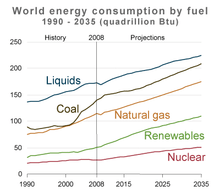Sustainability studies
Sustainability studies focuses on the interdisciplinary perspective of the sustainability concept. Programs include instruction in sustainable development, geography, environmental policies, ethics, ecology, landscape architecture, city and regional planning, economics, natural resources, sociology, and anthropology.[1] Sustainability studies also focuses on the importance of climate change, poverty and development.[2] Studies in Sustainability are now available in many different universities across America. The main goal of sustainability studies is for students to find ways to develop creative solutions to the crisis in environmental sustainability.[3]

The shift towards sustainability
Towards the end of 1980s a new focus emerged in the global sphere in which a focus on the environment and ecological sustainability emerged. In 1987 the Brundtland Report was delivered by the World Commission on Environment and Development.[4] The commission was appointed to examine the consequences of global environmental change and was chaired by Norway’s Prime Minister, Gro Harlem Brundtland.[5] It introduced the concept of sustainable development, which it defined as “development that meets the needs of the present without compromising the ability of future generations to meet their own needs”.[6] This report started a paradigm shift in which global actors soon began to engage in initiatives that vowed to focus on sustainable development.

Five years after the report was launched the UN Earth’s Summitt in Rio adopted the Framework Convention on Climate Change.[5] Five years later this policy developed into the creation of the Kyoto Protocol, a plan in which rich nations pledged to reduce carbon emissions.[5] All countries that partook in the UNFCCC also signed onto the Kyoto Protocol. Unfortunately progress towards sustainability stalled when the Kyoto Protocol was never ratified by the United States, and other nations consequently ignored their pledges to the agreement.[5]
Recently, the UN Intergovernmental Panel on Climate Change released a report that says “urgent and unprecedented changes are needed to reach the target” of keeping the global temperature at moderate levels.[7] They state that countries MUST follow the Paris Agreement pledge to keep temperatures between 1.5 degrees Celsius and 2 degrees Celsius, otherwise the earth faces the complete eradication of corals and the melting of the Arctic ice caps.[7] The Panel continues to explain that a rise in temperatures would also trigger catastrophic results in the form of intense natural disasters, unpredictable weather, and food shortages. In order to prevent this outcome governments would need to require a “supercharged roll-back of emissions courses that have built up over the past 250 years.”[7] In order to do so developments in land use and technological changes are necessary. Carbon pollution would have to be cut by 45% by 2030 and come down to 0 by 2050.[7] Although this would require carbon prices to be three to four times higher, the consequences of global warming at this rate would be far more severe. The world is currently on course to reaching 3 degrees Celsius of global warming, and scientists have 12 years to impose significant changes to prevent this from happening.[7] This shift towards environmental protection demands for a workforce that is more heavily dedicated to studying sustainable development. Individuals studying sustainable development will likely be focused on reducing the climate in which catastrophic global warming would take place.
Careers in sustainability studies
Sustainability studies is a degree which emphasizes an interdisciplinary approach. Since it covers a wide variety of topics from multiple perspectives, it can lead into multiple avenues for a future career such as:
- Law
- Politics
- Policy and Planning
- Journalism
- Business and Architectural Design
- Marine Sciences
- Sustainability Professionals
The salary range for a professional involved in sustainability studies is based on the average salaries of those involved in engineering and environmental sciences.[8] This starting salary ranged from 75 000 on the low end, to 93 000.[8] Chief sustainability executives can earn an average of 167 000.[8]
See also
References
- Detail for CIP Code 30.3301, Title: Sustainability Studies.. Classification of Instructional Programs (CIP), The Integrated Postsecondary Education Data System (IPEDS), National Center for Education Statistics, US Department of Education Institute of Education Sciences. Accessed 10 May 2011
- "Compare 85 Masters Programs in Sustainability Studies". MASTERSTUDIES.COM. Retrieved 10 March 2018.
- Cohen, Steven. "The Growing Field of Sustainability Studies". HuffPost. Retrieved 10 March 2018.
- "History and Sustainability". www.histecon.magd.cam.ac.uk. Retrieved 2018-12-03.
- "The paradigm shift towards sustainability must go ahead at full speed". D+C. Retrieved 2018-12-03.
- Du Pisani, Jacobus A. (June 2006). "Sustainable development – historical roots of the concept". Environmental Sciences. 3 (2): 83–96. doi:10.1080/15693430600688831. ISSN 1569-3430.
- Watts, Jonathan (2018-10-08). "We have 12 years to limit climate change catastrophe, warns UN". the Guardian. Retrieved 2018-12-03.
- "What is a Sustainability Studies Major and is it Right for Me? | Career Advice & Interview Tips | WayUp Guide". Career Advice & Interview Tips | WayUp Guide. 2017-07-31. Retrieved 2018-12-03.